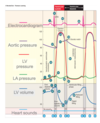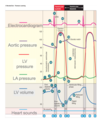Murmurs Flashcards
(25 cards)
S1

- loudest at the apex
- sound of the tricuspid and mitral valves closing
- after S1 and before S2 is systole
- systole begins at #9: when LV pressure exceeds LA pressure
- systole ends at #17: when aortic and pulmonic valves close
S2

- heard loudest at the base
- sound of pulmonic and aortic valves closing
- after S2 abd before the next S1 is diastole
- diastole beins at #17: when aortic and pulmonic valves close
- diastole ends at #9: when tricuspid and mitral valves close
turbulent flow
- increased flow rate –> increased CO
- narrowing —> increased flow
- valve stenosis
- valve regurgitation
- other (VSD, HCM, PDA)


Grading a Murmur

systolic murmurs
•closing of tricsupid and mitral valves
1) crescendo-decrescendo
- aortic stenosis
- pulmonic stenosis
- hypertrophic cardiac myopathy
2) holosysolic
- mitral regurgitation
- tricuspid regurgitation
- VSD

- systolic - crescendo decrescendo
- aortic stenosis
- pulmonic stenosis
- hypertrophic cardiac myopathy

- systolic - holosystolic
- mitral regeurgitation
- tricuspid regurgitation
- VSD
diastolic murmurs
- closing of aorta and pulmonic valves
- decrescendo
- aortic regurgitation
- pulmonic regurgitation
•rumble
- mitral stenosis
- tricuspid stenosis

- diastolic - decrescendo
- aortic regirgitation
- pulmonic regurgitation

- diastolic - rumble
- mitral stenosis
- tricsupid stenosis
aortic stenosis

- systolic murmur - left side
- crescendo decrescendo
- starts when aortic valve opens (#12) , stops when closes (#17)
- blood having a hard time pushing through
- syncope, angina, dyspnea

mitral regurgitation

- systolic murmur - left side
- holosystolic
- begins when mitral valve closes (#9) and ends when mitral valve opens again (#21)
- starts as soon as systolic pressure is greater than atrial pressure, lasts as long as LV pressure exceeds LA pressure

aortic regurgitation

- diastolic murmrur - left side
- decrescendo
- starts when aortic valve closes ( #17) and continues until aotic valve opens again (#12)
- heard better while pateint is sitting up, can cause head bobbing, murmur over femorals
- during diastole, blood leaks back
- high pulse pressure (systolic BP goes up a little, diastolic BP goes down)
- can cause a flow murmur during suystole due to extra blood

mitral stenosis

- diastolic - left side
- rumble
- blood has a hard time pushing throuh
- starts when mitral valve opens (#21) and ends when mitral valve closes (#9)
- can end up causing a fib and pulmonary edema

inspiration
- Increase right-sided murmurs
- Decrease left-sided murmurs (see exceptions below)
expiration
- Decrease right-sided murmurs
- Increase left-sided murmurs (see exceptions below)
Increase Preload—Leg Raise (increase venous return)
- Increase most murmurs
- Except decrease HCM
Decrease Preload—Standing, Valsalva (decrease venous return)
bear down, increase pressure in chest
- Decrease most murmurs
- Except increase HCM
Increase afterload (handgrip/phenylephrine)
- Increase backward flow
- Increase MR and VSD
- Decrease AS and MS
- Decrease HCM (more blood in ventricles, increases size of ventricle and opens up outlfow tract)
Decrease afterload (vasodilator—amyl nitrate)
- decrease backward flow
- decrease MR and VSD
- increase AS and MS
- increase HCM
continuous murmur
•patent ductus arteriosus
S3
- early in diastole (after S2)
- hear failure with reduced EF
- more blood left in LV
- blood hits blood —> vibration of walls
•chronic mitral regurgitation
- bllod into atrium, whcih eventually gets back to lV
- bllod hits blood —> vibration of walls
•children and pregnant women - not pathologic
S4
- late in diastole (before S1)
- contraction of atria pushes extra blood in
- anyone with stiff heart
- HTN
- HFpEF
- blood hits stiff wall
- with a fib, no S4 heard


